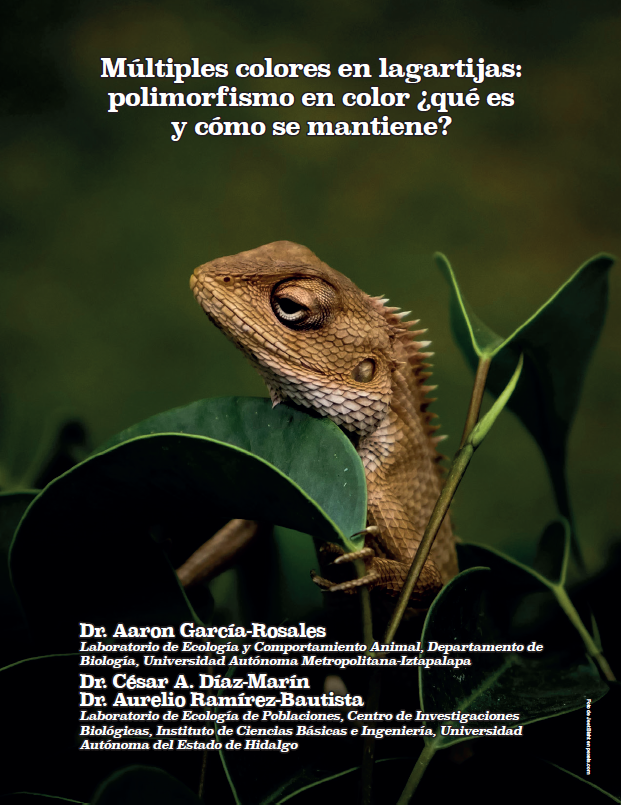Múltiples colores en lagartijas
polimorfismo en color ¿qué es y cómo se mantiene?
Keywords:
Color morphs, competitiveness, reproduction strategies, aggressiveness
Abstract
Many species of lizards that live in the same population can show different colors in the same region of the body. In biology, this phenomenon is known as coloration polymorphism, a phenomenon that, although not very common in nature, is not that rare either. In this review, some processes that contribute to the maintenance and evolution of color polymorphism are described; as well as some of the most representative studies carried out with different species of lizards.
Downloads
Download data is not yet available.
References
Bastiaans, E., Bastiaans, M. J., Morinaga, G., Gaytán, J. G. C., Marshall, J. C., Bane, B., Mendez de la Cruz, F. y Sinervo, B., Female preference for sympatric vs. allopatric male throat color morphs in the mesquite lizard (Sceloporus grammicus) species complex, PloS one, 9[4], pp. 1-12, 2014. Doi: 10.1371/journal.pone.0093197
Galeotti, P., Rubolini, D., Dunn, P. O. y Fasola, M., Colour polymorphism in birds: causes and functions, Journal of Evolutionary Biology, 16[4], pp. 635-646, 2003. Doi: 10.1046/j.1420-9101.2003.00569.x
Gray, S. M. y McKinnon, J. S., Linking color polymorphism maintenance and speciation, Trends in Ecology & Evolution, 22[2], pp. 71-79, 2007. Doi: 10.1016/j. tree.2006.10.005
Lattanzio, M. S., Climate mediates color morph turnover in a species exhibiting alternative reproductive strategies, Scientific Reports, 12, pp. 1-13, 2022. Doi: 10.1038/s41598-022-12300-7
Lattanzio, M. S. y Miles, D. B., Trophic niche divergence among colour morphs that exhibit alternative mating tactics, Royal Society Open Science, 3[4], pp. 1-13, 2016. Doi: 10.1098/rsos.150531
McLean, C. A., Stuart‐Fox, D. y Moussalli, A., Phylogeographic structure, demographic history and morph composition in a colour polymorphic lizard, Journal of Evolutionary Biology, 27[10], pp. 2123-2137, 2014. Doi: 10.1111/jeb.12464
Scali, S., Sacchi, R., Mangiacotti, M., Pupin, F., Gentilli, A., Zucchi, C., Sannolo, M., Pavesi, M. y Zuffi, M. A., Does a polymorphic species have a ‘polymorphic’diet? A case study from a lacertid lizard, Biological Journal of the Linnean Society, 117[3], pp. 492-502. 2016. Doi: 10.1111/ bij.12652
Sinervo, B. y Lively, C. M., The rock–paper– scissors game and the evolution of alternative male strategies, Nature, 380[6571], 240-243, 1996. Doi:10.1038/380240A0
Sinervo, B., Miles, D. B., Frankino, W. A., Klukowski, M. y DeNardo, D. F., Testosterone, endurance, and Darwinian fitness: natural and sexual selection on the physiological bases of alternative male behaviors in side-blotched lizards, Hormones and Behavior, 38[4], pp. 222-233, 2000. doi: 10.1006/hbeh.2000.1622
Taborsky, M., Oliveira, R. F. y Brockmann, H. J., The evolution of alternative reproductive tactics: concepts and questions. En Oliveira, R. F., Taborsky, M. y Brockmann, H. J., (Eds.), Alternative reproductive tactics: an integrative approach, Cambridge University Press, 2008, pp. 1-21
Galeotti, P., Rubolini, D., Dunn, P. O. y Fasola, M., Colour polymorphism in birds: causes and functions, Journal of Evolutionary Biology, 16[4], pp. 635-646, 2003. Doi: 10.1046/j.1420-9101.2003.00569.x
Gray, S. M. y McKinnon, J. S., Linking color polymorphism maintenance and speciation, Trends in Ecology & Evolution, 22[2], pp. 71-79, 2007. Doi: 10.1016/j. tree.2006.10.005
Lattanzio, M. S., Climate mediates color morph turnover in a species exhibiting alternative reproductive strategies, Scientific Reports, 12, pp. 1-13, 2022. Doi: 10.1038/s41598-022-12300-7
Lattanzio, M. S. y Miles, D. B., Trophic niche divergence among colour morphs that exhibit alternative mating tactics, Royal Society Open Science, 3[4], pp. 1-13, 2016. Doi: 10.1098/rsos.150531
McLean, C. A., Stuart‐Fox, D. y Moussalli, A., Phylogeographic structure, demographic history and morph composition in a colour polymorphic lizard, Journal of Evolutionary Biology, 27[10], pp. 2123-2137, 2014. Doi: 10.1111/jeb.12464
Scali, S., Sacchi, R., Mangiacotti, M., Pupin, F., Gentilli, A., Zucchi, C., Sannolo, M., Pavesi, M. y Zuffi, M. A., Does a polymorphic species have a ‘polymorphic’diet? A case study from a lacertid lizard, Biological Journal of the Linnean Society, 117[3], pp. 492-502. 2016. Doi: 10.1111/ bij.12652
Sinervo, B. y Lively, C. M., The rock–paper– scissors game and the evolution of alternative male strategies, Nature, 380[6571], 240-243, 1996. Doi:10.1038/380240A0
Sinervo, B., Miles, D. B., Frankino, W. A., Klukowski, M. y DeNardo, D. F., Testosterone, endurance, and Darwinian fitness: natural and sexual selection on the physiological bases of alternative male behaviors in side-blotched lizards, Hormones and Behavior, 38[4], pp. 222-233, 2000. doi: 10.1006/hbeh.2000.1622
Taborsky, M., Oliveira, R. F. y Brockmann, H. J., The evolution of alternative reproductive tactics: concepts and questions. En Oliveira, R. F., Taborsky, M. y Brockmann, H. J., (Eds.), Alternative reproductive tactics: an integrative approach, Cambridge University Press, 2008, pp. 1-21

Published
2024-10-03
How to Cite
García-Rosales, A., Díaz-Marín, C. A., & Ramírez-Bautista, A. (2024). Múltiples colores en lagartijas : polimorfismo en color ¿qué es y cómo se mantiene?. Contactos, Revista De Educación En Ciencias E Ingeniería, (134), 56 - 64. Retrieved from https://contactos.izt.uam.mx/index.php/contactos/article/view/413
Section
Artículos





